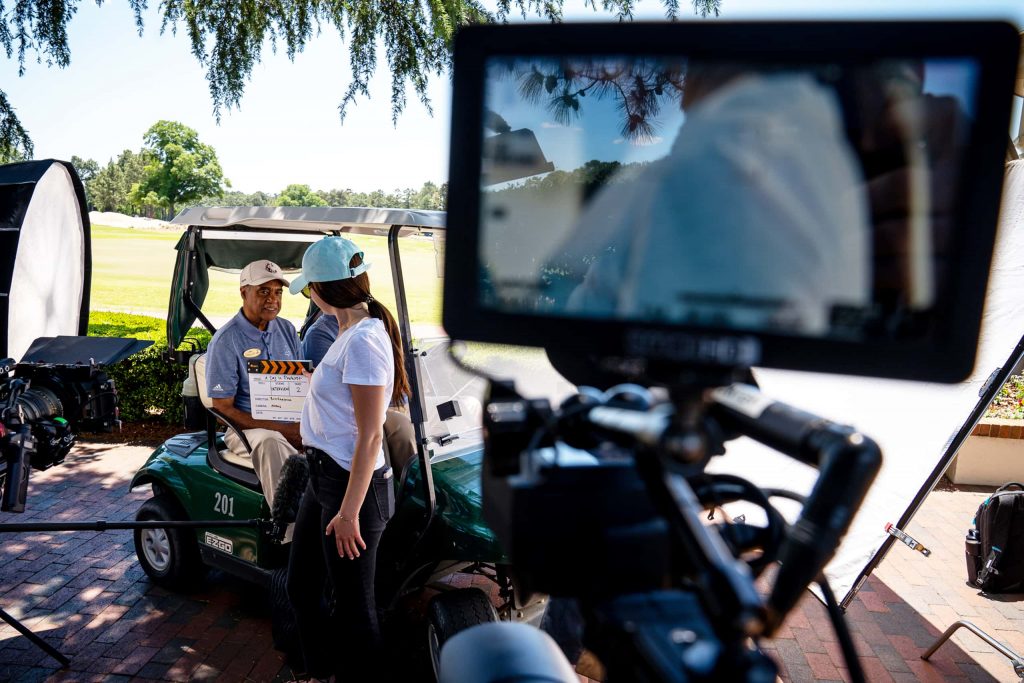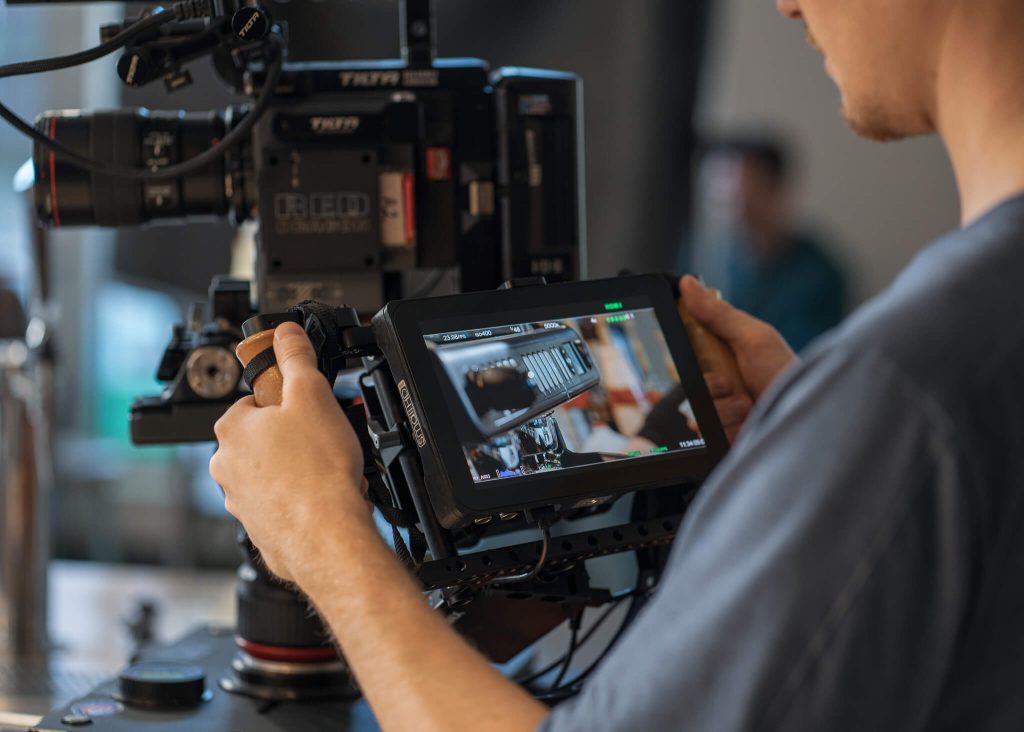We went behind the scenes with our TriMark Productions video team as they shot a 30-second commercial spot to understand everything that happens on set. From the Director giving notes to talent to the gaffer getting the lighting just right, we got to see all the moving pieces that go into getting the perfect shot. Here’s how our sneak peek of the video production process went.
Who Does What On Production Day?
A video crew is a bit like an army—everyone has a specific job within an important hierarchy. While most video professionals are multitaskers capable of filling many roles, the more specific a crew member’s focus is, the higher the production quality will be. Here are the key players found on every TriMark Productions set:
The Director
The job of the creative lead on set is to turn words on a page into visuals on a screen. Directing talent, conducting interviews and working with the Director of Photography to design shots that convey the story and brand message all fall under their responsibility.
The Director of Photography
They’re in charge of all aspects of capturing footage, including lighting, lens choice, camera operation and shot design. Frequently, a Director of Photography will lead an entire camera department, which may include assistants, grips, gaffers and more.
The Producer
Their role is to manage the logistical and budgetary aspects of the project. They are responsible for ensuring the Director, Director of Photography and other key creative roles have the tools and information needed to bring a project to fruition.
The Sound Op
A Sound Op is the ears of the production, responsible for recording, mixing and organizing all necessary sound—from interview voices to sound effects.
The Gaffer
The gaffer is in charge of lighting, including the maintenance of equipment. They work directly with the Director of Photography to design and place lights and other gear to create a style, look and tone for a particular shot. If the shoot is outdoors, they have the added challenge of maintaining consistent lighting throughout the day rather than in a controlled indoor environment.
The Grip
Their tasks range from being an extra set of hands for carrying gear to complex production engineering. Other responsibilities include rigging cameras, lights and other equipment to achieve a particular effect.

What Exactly Happens on Production Day?
Every day on set has the same process of setting up, filming scenes, rearranging sets and tearing down. But how long does it all take? Like almost everything related to digital marketing, it depends.
Productions can range from three to four hours to several days. An average shoot day is eight to 10 hours from setup to teardown—and most of that time is spent setting up, tearing down, changing locations or getting a shot just right. The more elements a production has, the longer it takes to capture.
Here’s what a typical day on set for a 30-second commercial can look like:
8 a.m. – Call Time
Cast and crew members are told when to arrive on set days before the shoot. As soon as everyone is there, a brief production meeting is held to ensure everyone knows their job, and the setup process begins. Sets, cameras, lights, talent and all other elements for the first scene are put into place.
9 a.m. – Scene 1 Filming Begins
This is where the real fun starts. Finally, all the ideas begin to come to life. Some scenes may only need three or four takes to get the perfect shot, while others may take much more than that to get the ideal lighting, angles, actions or other elements.
10:30 – Turnaround for Scene 2
Once the leads on set are satisfied with all the footage from the first scene, it’s time to move on to the second. However, all the elements used for the first scene have to be rearranged and set back up, talent has to be briefed on the upcoming shot and lighting has to be readjusted. Sometimes, there is an entire change in location, which can take a lot of time out of the day.
11 a.m. – Scene 2 Filming
After everything is back in place, the team has all the equipment fine-tuned to the proper setting and the talent is ready, the next scene can begin filming. Everyone on set is more comfortable with their role by this point, and any hiccups that may have occurred in the first scene are typically smoothed out.
12:30 p.m. – Lunch Break
Production can be grueling, so ensuring the cast and crew are hydrated, fed and have breaks is a crucial part of production management. Having lunches catered to the filming location keeps everyone on set the entire day and ensures production day stays on schedule.
1 p.m. – Turnaround For Scene 3
Now that everyone is full, hydrated and rested, it’s time to get back to work. All elements for the final scene are put in place to end the day strong. If the shoot is outdoors, it may take a bit longer to readjust camera angles and lighting with the afternoon sun to keep the shots consistent with what was filmed earlier in the morning.
1:30 – Scene 3 Filming
Finally, the story we’re telling comes alive. Now is the time to shoot the last scene, get any last-minute angles, take still shots for future social media posts and check the shot list one last time to make sure everything was captured. But everyone can’t go home just yet.
3 p.m. – Wrap
Even when all the filming is complete, the work of tearing down has just begun. With so much expensive equipment involved in the production process, everything must be broken down and stored away correctly. Like setup and turnarounds, this, too, takes time.
What Happens After Wrap?
The second the camera stops recording, the post-production process begins. Making a video is like baking a cake, and this is where all the ingredients are mixed together and thrown in the oven. Editing, music sourcing, color grading, recording voice-overs and animating all happen after wrap.
Once edits are complete, the video is delivered to the marketing strategists and the client, who will identify the platforms and strategies where the video can best communicate the brand’s message.
Whether your goal is to drive brand awareness or qualified leads, there’s a place in every strategy for video. Working with a team of marketing and creative professionals is the best way to maximize your content, tell your brand story and achieve your business goals. Passionate about integrated digital marketing, our experts can help you identify social media, web, CTV and OTT opportunities to share your video with your target audience and drive lasting results.





